Late Pleistocene Geomorphic Evolution of Cephalonia Island, Western Greece, Inferred from Uplifted Marine Terraces
Abstract
:1. Introduction
2. Regional Setting—Study Area
3. Materials and Methods
3.1. Mapping Marine Terraces
3.2. Microscope, Petrological and Microgeomorphological Analyses
3.3. Optically Stimulated Luminescence (OSL) Dating
3.4. Uplift Rates
4. Results
4.1. Mapping Marine Terraces
4.2. Microscope, Petrological and Microgeomorphological Analyses
4.3. Optically Stimulated Luminescence (OSL) Dating—Uplift Rates
5. Discussion
6. Conclusions
Author Contributions
Funding
Institutional Review Board Statement
Informed Consent Statement
Conflicts of Interest
References
- Bradley, W.C. Origin of marine-terrace deposits in the Santa Cruz area, California. Geol. Soc. Am. Bull. 1957, 68, 421–444. [Google Scholar] [CrossRef]
- Lajoie, K.R. Coastal tectonics. Act. Tect. 1986, 95–124. [Google Scholar]
- Muhs, D.R.; Kelsey, H.M.; Miller, G.H.; Kennedy, G.L.; Whelan, J.F.; McInelly, G.W. Age estimates and uplift rates for Late Pleistocene marine terraces: Southern Oregon portion of the Cascadia Forearc. J. Geophys. Res. 1990, 95, 6685–6698. [Google Scholar] [CrossRef] [Green Version]
- Anderson, R.; Densmore, A.; Ellist, M. The generation and degradation of marine terraces. Basin Res. 1999, 11, 7–19. [Google Scholar] [CrossRef]
- Rosenbloom, N.A.; Anderson, R.S. Hillslope and channel evolution in a marine terraced landscape, Santa Cruz, California. J. Geophys. Res. Solid Earth 1994, 99, 14013–14029. [Google Scholar] [CrossRef]
- Dupre, W.R. Reconstruction of paleo-wave conditions during the late Pleistocene from marine terrace deposits, Monterey Bay, California. Mar. Geol. 1984, 60, 435–454. [Google Scholar] [CrossRef]
- Trenhaile, A.S. Modeling the development of marine terraces on tectonically mobile rock coasts. Mar. Geol. 2002, 185, 341–361. [Google Scholar] [CrossRef]
- Marquardt, C.; Lavenu, A.; Ortlieb, L.; Godoy, E.; Comte, D. Coastal neotectonics in Southern Central Andes: Uplift and deformation of marine terraces in Northern Chile (27 S). Tectonophysics 2004, 394, 193–219. [Google Scholar] [CrossRef]
- Saillard, M.; Hall, S.R.; Audin, L.; Farber, D.L.; Herail, G.; Martinod, J.; Regard, V.; Finkel, R.C.; Bondoux, F. Non-steady long-term uplift rates and Pleistocene marine terrace development along the Andean margin of Chile (31o S) inferred from 10Be dating. Earth Planet. Sci. Lett. 2009, 277, 50–63. [Google Scholar] [CrossRef]
- Limber, P.W.; Murray, A.B. Beach and sea-cliff dynamics as a driver of longterm rocky coastline evolution and stability. Geology 2011, 39, 1147–1150. [Google Scholar] [CrossRef] [Green Version]
- Muhs, D.R.; Rockwell, T.K.; Kennedy, G.L. Late Quaternary uplift rates of marine terraces on the Pacific coast of North America, southern Oregon to Baja California. Quat. Int. 1992, 15, 121–133. [Google Scholar] [CrossRef]
- Imbrie, J.; Hays, J.D.; Martinson, D.G.; McIntyre, A.; Mix, A.C.; Morley, J.J.; Pisias, N.G.; Prell, W.L.; Shackleton, N.J. The orbital theory of Pleistocene climate: Support from a revised chronology of the marine 18O record. In Milankovitch and Climate, Part 1; Berger, A., Ed.; D. Reidel Publishing Company: Dordrecht, The Netherlands, 1984; pp. 269–1305. [Google Scholar]
- Chappell, J.; Shackleton, N.J. Oxygen isotopes and sea level. Nature 1986, 324, 137–140. [Google Scholar] [CrossRef]
- Bassinot, F.C.; Labeyrie, L.D.; Vincent, E.; Quidelleur, X.; Shackleton, N.J.; Lancelot, Y. The astronomical theory of climate and the age of the Brunhes-Matuyama magnetic reversal. Earth Planet. Sci. Lett. 1994, 126, 91–108. [Google Scholar] [CrossRef]
- Waelbroeck, C.; Labeyrie, L.; Michel, E.; Duplessy, J.C.; McManus, J.F.; Lambeck, K.; Balbon, E.; Labracherie, M. Sea-level and deep water temperature changes derived from benthic foraminifera isotopic records. Quat. Sci. Rev. 2002, 21, 295–305. [Google Scholar] [CrossRef]
- Rohling, E.; Grant, K.; Bolshaw, M.; Roberts, A.; Siddall, M.; Hemleben, C.; Kucera, M. Antarctic temperature and global sea level closely coupled over the past five glacial cycles. Nat. Geosci. 2009, 2, 500–504. [Google Scholar] [CrossRef]
- Armijo, R.; Meyer, B.; King, G.C.P.; Rigo, A.; Papanastassiou, D. Quaternary evolution of the Corinth Rift and its implications for the Late Cenozoic evolution of the Aegean. Geophys. J. Int. 1996, 126, 11–53. [Google Scholar] [CrossRef] [Green Version]
- Tortorici, G.; Bianca, M.; de Guidi, G.; Monaco, C.; Tortorici, L. Fault activity and marine terracing in the Capo Vaticano area (s. Calabria) during the Middle-Late Quaternary. Quat. Int. 2003, 101, 269–278. [Google Scholar] [CrossRef]
- Upson, J.E. Former marine shorelines of the Gaviota Quadrangle, Santa Barbara County, California. J. Geol. 1951, 59, 415–446. [Google Scholar] [CrossRef]
- Bloom, A.L.; Broecker, W.S.; Chappell, J.; Matthews, R.K.; Mesolella, K.J. Quaternary sea level fluctuations on a tectonic coast; new 230Th/234U dates from the Huon Peninsula, New Guinea. Quat. Res. 1974, 4, 185–205. [Google Scholar] [CrossRef]
- Ota, Y. Late Quaternary vertical movement in Japan estimated from deformed shorelines. In Quaternary Studies; Suggate, R.P., Creswell, M.M., Eds.; Royal Society of New Zealand: Wellington, New Zealand, 1975; pp. 231–239. [Google Scholar]
- Muhs, D.R.; Szabo, B.J. Uranium-series age of the Eel Point terrace, San Clemente Island, California. Geology 1982, 10, 23–26. [Google Scholar] [CrossRef] [Green Version]
- Sarna-Wojcicki, A.M.; Lajoie, K.R.; Yerkes, R.F. Recurrent Holocene displacement on the Javon Canyon Fault; a comparison of fault-movement history with calculated average recurrence intervals. In Recent Reverse Faulting in the Transverse Ranges, California; Geological Survey: Reston, VA, USA, 1987; p. 1339. [Google Scholar]
- Rockwell, T.; Nolan, J.; Johnson, D.L.; Patterson, R.H. Ages and deformation of marine terraces between Point Conception and Gaviota, Western Transverse Ranges, California. SEPM Spec. Publ. 1992, 48, 333–341. [Google Scholar]
- Ota, Y.; Chappell, J.; Kelley, R.; Yonekura, N.; Matsumoto, E.; Nishimura, T. Holocene coral reef terraces and coseismic uplift of Huon Peninsula, Papua New Guinea. Quat. Res. 1993, 40, 177–188. [Google Scholar] [CrossRef]
- Perg, L.A.; Anderson, R.S.; Finkel, R.C. Use of a new 10Be and 26Al inventory method to date marine terraces, Santa Cruz, California, USA. Geology 2001, 29, 879–882. [Google Scholar] [CrossRef]
- Bookhagen, B.; Echtler, H.P.; Melnick, D.; Strecker, M.R.; Spencer, J.Q.G. Using uplifted Holocene beach berms for paleoseismic analysis on the Santa Maria Island, southcentral Chile. Geophys. Res. Lett. 2006, 33, 5. [Google Scholar] [CrossRef] [Green Version]
- Muhs, D.R.; Simmons, K.R.; Schumann, R.R.; Groves, L.T.; Mitrovica, J.X.; Laurel, D. Sea-level history during the Last Interglacial complex on San Nicolas Island, California: Implications for glacial isostatic adjustment processes, paleozoogeography and tectonics. Quat. Sci. Rev. 2012, 37, 1–25. [Google Scholar] [CrossRef]
- Karymbalis, E.; Tsanakas, K.; Karkani, A.; Evelpidou, N. Tectonics and Sea-Level Fluctuations. J. Mar. Sci. Eng. 2022, 10, 334. [Google Scholar] [CrossRef]
- Galbraith, R.F.; Roberts, R.G.; Laslett, G.M.; Yoshida, H.; Olley, J.M. Optical dating of single and multiple grains of quartz from Jinmium rock shelter, northern Australia: Part I, experimental design and statistical models. Archaeometry 1999, 41, 339–364. [Google Scholar] [CrossRef]
- Gaki-Papanastassiou, K.; Karymbalis, E.; Papanastassiou, D.; Maroukian, H. Quaternary marine terraces as indicators of neotectonic activity of the Ierapetra normal fault SE Crete (Greece). Geomorphology 2009, 104, 38–46. [Google Scholar] [CrossRef]
- Papanastassiou, D.; Cundy, A.; Gaki-Papanastassiou, K.; Frogley, M.; Tsanakas, K.; Maroukian, H. The uplifted terraces of the Arkitsa region, NW Evoikos Gulf, Greece: A result of combined tectonic and volcanic processes? J. Geol. 2014, 122, 397–410. [Google Scholar] [CrossRef] [Green Version]
- Karymbalis, E.; Papanastassiou, D.; Gaki-Papanastassiou, K.; Tsanakas, K.; Maroukian, H. Geomorphological study of Cephalonia Island, Ionian Sea, Western Greece. J. Maps 2013, 9, 121–134. [Google Scholar] [CrossRef]
- Sachpazi, M.; Hirn, A.; Clement, C.; Haslinger, F.; Laigle, M.; Kissling, E.; Charvis, P.; Hello, Y.; Lepine, J.C.; Sapin, M.; et al. Western Hellenic subduction and Cephalonia Transform: Local earthquakes and plate transport and strain. Tectonophysics 2000, 319, 301–319. [Google Scholar] [CrossRef]
- Sorel, D. Etude Néotectonique des îles Ioniennes de Céphalonie et de Zante et de l’Elide Occidentale (Grèce). Thèse 3e cycle, University Paris Sud Orsay, Bures-sur-Yvette, France, 1976. [Google Scholar]
- Stiros, S.C.; Pirazzoli, P.A.; Laborel, J.; Laborel-Deguen, F. The 1953 earthquake in Cephalonia (Western Hellenic Arc): Coastal uplift and halotectonic faulting. Geophys. J. Int. 1994, 117, 834–849. [Google Scholar] [CrossRef] [Green Version]
- Koukouvelas, I.; Mpresiakas, A.; Sokos, E.; Doutsos, T. The tectonic setting and earthquake ground hazards of the 1993 Pyrgos earthquake, Peloponnese, Greece. J. Geol. Soc. 1996, 153, 39–49. [Google Scholar] [CrossRef]
- Clement, C.; Hirn, A.; Charvis, P.; Sachpazi, M.; Marnelis, F. Seismic structure and the active Hellenic subduction in the Ionian islands. Tectonophysics 2000, 329, 141–156. [Google Scholar] [CrossRef]
- Lagios, E.; Sakkas, V.; Papadimitriou, P.; Damiata, B.N.; Parcharidis, I.; Chousianitis, K.; Vassilopoulou, S. Crustal deformation in the Central Ionian Islands (Greece): Results from DGPS and DInSAR analyses (1995–2006). Tectonophysics 2007, 444, 119–145. [Google Scholar] [CrossRef]
- Hollenstein, C.H.; Müller, M.D.; Geiger, A.; Kahle, H.G. Crustal motion and deformation in Greece from a decade of GPS measurements 1993–2003. Tectonophysics 2008, 449, 17–40. [Google Scholar] [CrossRef]
- Louvari, E.; Kiratzi, A.A.; Papazachos, B.C. The Cephalonia transform fault and its extension to western Lefkada Island (Greece). Tectonophysics 1999, 308, 223–236. [Google Scholar] [CrossRef]
- Scordilis, E.; Karakaisis, G.; Karakostas, B.; Panagiotopoulos, D.; Comninakis, P.; Papazachos, B. Evidence for transform faulting in the Ionian Sea: The Cephalonia Island earthquake sequence of 1983. Pure Appl. Geophys. 1985, 123, 388–397. [Google Scholar] [CrossRef]
- Evelpidou, N.; Karkani, A.; Kázmér, M.; Pirazzoli, P. Late Holocene shorelines deduced from tidal notches on both sides of the Ionian thrust (Greece): Fiscardo peninsula (Cephalonia) and Ithaca island. Geol. Acta 2016, 14, 13–24. [Google Scholar]
- Tsanakas, K.; Karymbalis, E.; Cundy, A.; Gaki-Papanastassiou, K.; Papanastassiou, G.; Drinia, H.; Koskeridou, E.; Maroukian, H. Late Holocene geomorphic evolution of the Livadi coastal plain, gulf of Argostoli, Cephalonia island, western Greece. Geogr. Fis. Din. Quat. 2019, 42, 43–60. [Google Scholar] [CrossRef]
- Willershäuser, T.; Vött, A.; Brückner, H.; Bareth, G.; Nelle, O.; Nadeau, M.J.; Hadler, H.; Ntageretzis, K. Holocene tsunami landfalls along the shores of the inner Gulf of Argostoli (Cefalonia Island, Greece). Z. Für Geomorphol. 2013, 57 (Suppl. 4), 105–138. [Google Scholar] [CrossRef]
- Valkaniotis, S.; Ganas, A.; Papathanassiou, G.; Papanikolaou, M. Field observations of geological effects triggered by the January-February 2014 Cephalonia (Ionian Sea, Greece) earthquakes. Tectonophysics 2014, 630, 150–157. [Google Scholar] [CrossRef]
- Pirazzoli, P.A.; Stiros, S.C.; Laborel, J.; Laborel-Deguen, F.; Arnold, M.; Papageorgiou, S.; Morhange, C. Late Holocene shoreline changes related to palaeoseismic events in the Ionian Islands, Greece. Holocene 1994, 4, 397–405. [Google Scholar] [CrossRef]
- Lagios, E.; Papadimitriou, P.; Novali, F.; Sakkas, V.; Fumagalli, A.; Vlachou, K.; Del Conte, S. Combined seismicity pattern analysis, DGPS and PSInSAR studies in the broader area of Cephalonia (Greece). Tectonophysics 2012, 524, 43–58. [Google Scholar] [CrossRef]
- Institute of Geology and Mineral Exploration (IGME). 1985, Geological map of Kefalonia Island. Scale 1:50000; Institute of Geology and Mineral Exploration (IGME): Thessaloniki, Greece, 1985. [Google Scholar]
- Köppen, W. Versuch einer Klassifikation der Klimate, vorzugsweise nach ihren Beziehungen zur Pflanzenwelt. Geogr. Z. 1900, 6, 657–679. [Google Scholar]
- Köppen, W.; Geiger, R. Handbuch der Klimatologie; Gebrueder Borntraeger: Berlin, Germany, 1930. [Google Scholar]
- Hellenic National Meteorological Service. 2010. Available online: http://emy.gr/emy/en (accessed on 15 November 2021).
- Tsanakas, K.; Karymbalis, E.; Gaki-Papanastassiou, K.; Maroukian, H. Geomorphology of the Pieria Mtns, Northern Greece. J. Maps 2019, 15, 499–508. [Google Scholar] [CrossRef] [Green Version]
- Bowles, C.J.; Cowgill, E. Discovering marine terraces using airborne LiDAR along the Mendocino-Sonoma coast, northern California. Geosphere 2012, 8, 386–402. [Google Scholar] [CrossRef]
- Merritts, D.; Bull, W.B. Interpreting Quaternary uplift rates at the Mendocino triple junction, northern California, from uplifted marine terraces. Geology 1989, 17, 1020–1024. [Google Scholar] [CrossRef]
- Strobl, M.; Hetzel, R.; Fassoulas, C.; Kubik, P.W. A long-term rock uplift rate for eastern Crete and geodynamic implications for the Hellenic subduction zone. J. Geodyn. 2014, 78, 21–31. [Google Scholar] [CrossRef]
- Chappel, J.; Omura, A.; Esat, T.; McCulloch, M.; Pandolfi, J.; Ota, Y.; Pillans, B. Reconcilation of late Quaternary sea levels derived from coral terraces at HuonPeninsula with deep sea oxygen isotope records. Earth Planet. Sci. Lett. 1996, 141, 227–236. [Google Scholar] [CrossRef]
- Munnecke, A.; Westphal, H.; Reijmer, J.J.G.; Samtleben, C. Microspar development during early marine burial diagenesis: A comparison of Pliocene carbonates from the Bahamas with Silurian limestones from Gotland (Sweden). Sedimentology 1997, 44, 977–990. [Google Scholar] [CrossRef]
- Folk, R.L. Spectral Subdivision of Limestones Types. In In Classification of Carbonates Rocks. A Symposium; Ham, W.E., Ed.; American Association of Petroleum Geologist Memoirs: Tulsa, OK, USA, 1962; pp. 62–84. [Google Scholar]
- Aitken, M.J. Thermoluminescence Dating; Academic Press: Orlando, FL, USA; London, UK, 1985; p. 351. [Google Scholar]
- Liritzis, I.; Stamoulis, K.; Papachristodoulou, C.; Ioannides, K. A re-evaluation of radiation dose-rate conversion factors. Mediterr. Archaeol. Archaeom. 2013, 13, 1–15. [Google Scholar]
- Murray, A.S.; Wintle, A.G. Luminescence dating of quartz using an improved single-aliquot regenerative-dose protocol. Radiat. Meas. 2000, 32, 57–73. [Google Scholar] [CrossRef]
- Prescott, J.R.; Hutton, J.T. Cosmic ray contribution to dose rates for luminescence and ESR dating: Large depths and long-term time variations. Radiat. Meas. 1994, 23, 497–500. [Google Scholar] [CrossRef]
- Muhs, D.R. Evidence for the timing and duration of the last interglacial period from high-precision uranium-series ages of corals on tectonically stable coastlines. Quat. Res. 2002, 58, 36–40. [Google Scholar] [CrossRef] [Green Version]
- Zazo, C.; Goy, J.L.; Dabrio, C.J.; Bardají, T.; Hillaire-Marcel, C.; Ghaleb, B.; Gonz alezDelgado, J.-A.; Soler, V. Pleistocene raised marine terraces of the Spanish Mediterranean and Atlantic coasts: Records of coastal uplift, sea-level highstands and climate changes. Mar. Geol. 2003, 194, 103–133. [Google Scholar] [CrossRef] [Green Version]
- Zecchin, M.; Civile, D.; Caffau, M.; Roda, C. Facies and cycle architecture of a Pleistocene marine terrace (Crotone, southern Italy): A sedimentary response to late Quaternary, high-frequency glacio-eustatic changes. Sediment. Geology 2009, 216, 138–157. [Google Scholar] [CrossRef]
- Bianca, M.; Catalano, S.; De Guidi, G.; Gueli, A.; Monaco, C.; Ristuccia, G.; Stella, G.; Tortorici, G.; Tortorici, L.; Troja, S. Luminescence chronology of Pleistocene marine terraces of Capo Vaticano peninsula (Calabria, southern Italy). Quat. Int. 2011, 232, 114–121. [Google Scholar] [CrossRef]
- Gurrola, L.D.; Keller, E.A.; Chen, J.H.; Owen, L.A.; Spencer, J.Q. Tectonic geomorphology of marine terraces: Santa Barbara fold belt, California. Geol. Soc. Am. Bull. 2014, 126, 219–233. [Google Scholar] [CrossRef]
- Lambeck, K. Late Pleistocene and Holocene sea-level change in Greece and south-western Turkey: A separation of eustatic, isostatic and tectonic contributions. Geophys. J. Int. 1995, 122, 1022–1044. [Google Scholar] [CrossRef] [Green Version]
- Gallen, S.F.; Wegmann, K.W.; Bohnenstiehl, D.R.; Pazzaglia, F.J.; Brandon, M.T.; Fassoulas, C. Active simultaneous uplift and margin-normal extension in a forearc high, Crete, Greece. Earth Plant. Sci. Lett. 2014, 398, 11–24. [Google Scholar] [CrossRef]
- Normand, R.; Simpson, G.; Herman, F.; Biswas, R.H.; Bahroudi, A.; Schneider, B. Dating and morpho-stratigraphy of uplifted marine terraces in the Makran subduction zone (Iran). Earth Surf. Dyn. 2019, 7, 321–344. [Google Scholar] [CrossRef] [Green Version]
- Snead, R.J. Recent Morphological changes along the coast of West Pakistan. Ann. Assoc. Am. Geogr. 1967, 57, 550–565. [Google Scholar] [CrossRef]
- Karymbalis, E.; Tsanakas, K.; Tsodoulos, I.; Gaki-Papanastassiou, K.; Papanastassiou, D.; Batzakis, D.-V.; Stamoulis, K. Late Quaternary Marine Terraces and Tectonic Uplift Rates of the Broader Neapolis Area (SE Peloponnese, Greece). J. Mar. Sci. Eng. 2022, 10, 99. [Google Scholar] [CrossRef]
- De Gelder, G.; Fernandez-Blanco, D.; Lacassin, R.; Armijo, R.; Delorme, A.; Jara-Muñoz, J.; Melnick, D. Corinth terraces revisited: Improved paleoshoreline determination using Pleiades-DEM. Geotecton. Res. 2015, 97, 12–14. [Google Scholar] [CrossRef] [Green Version]
- Lisiecki, L.E.; Raymo, M.E. A Pliocene–Pleistocene stack of 57 globally distributed benthic d18O records. Paleoceanography 2005, 20, PA1003. [Google Scholar]
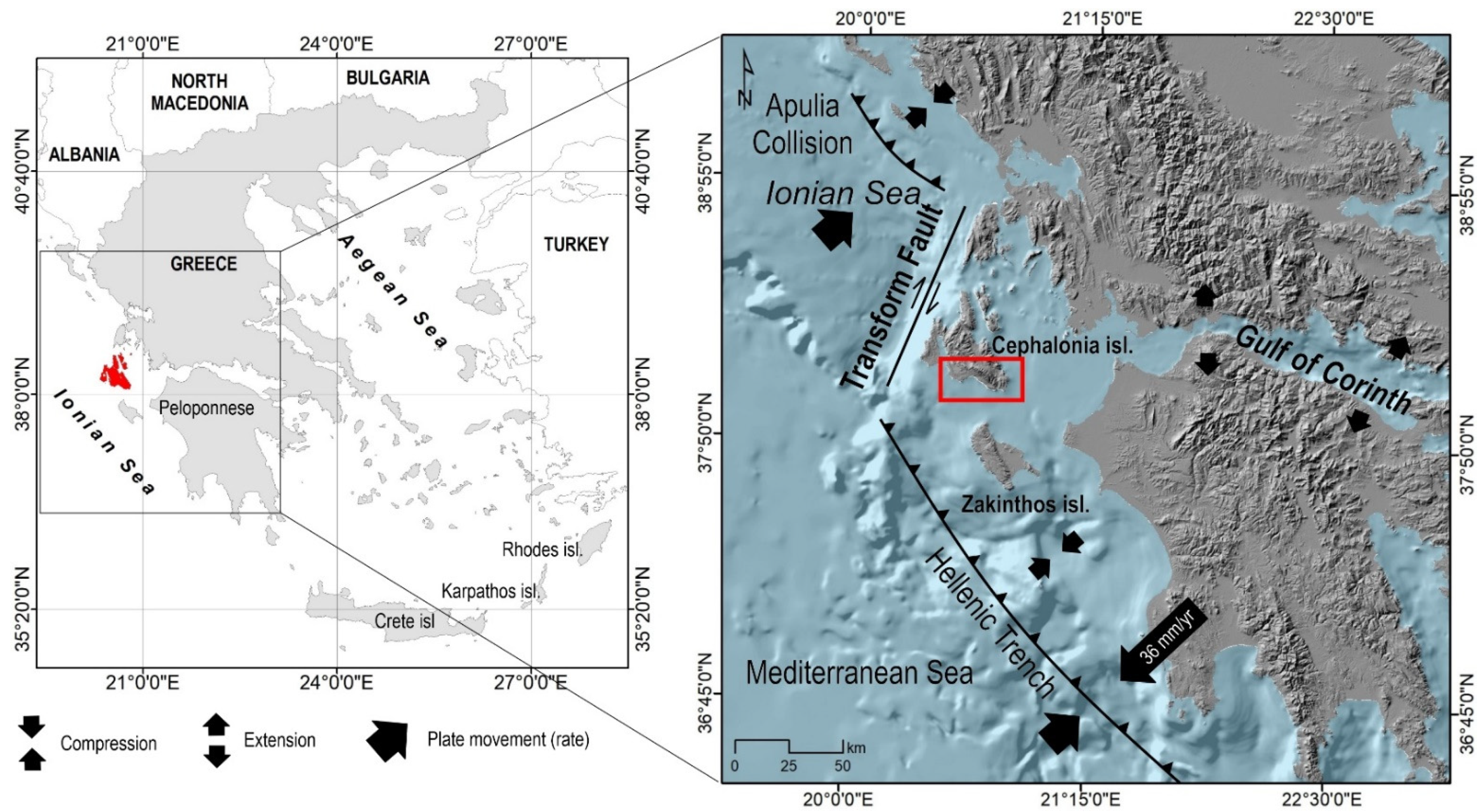

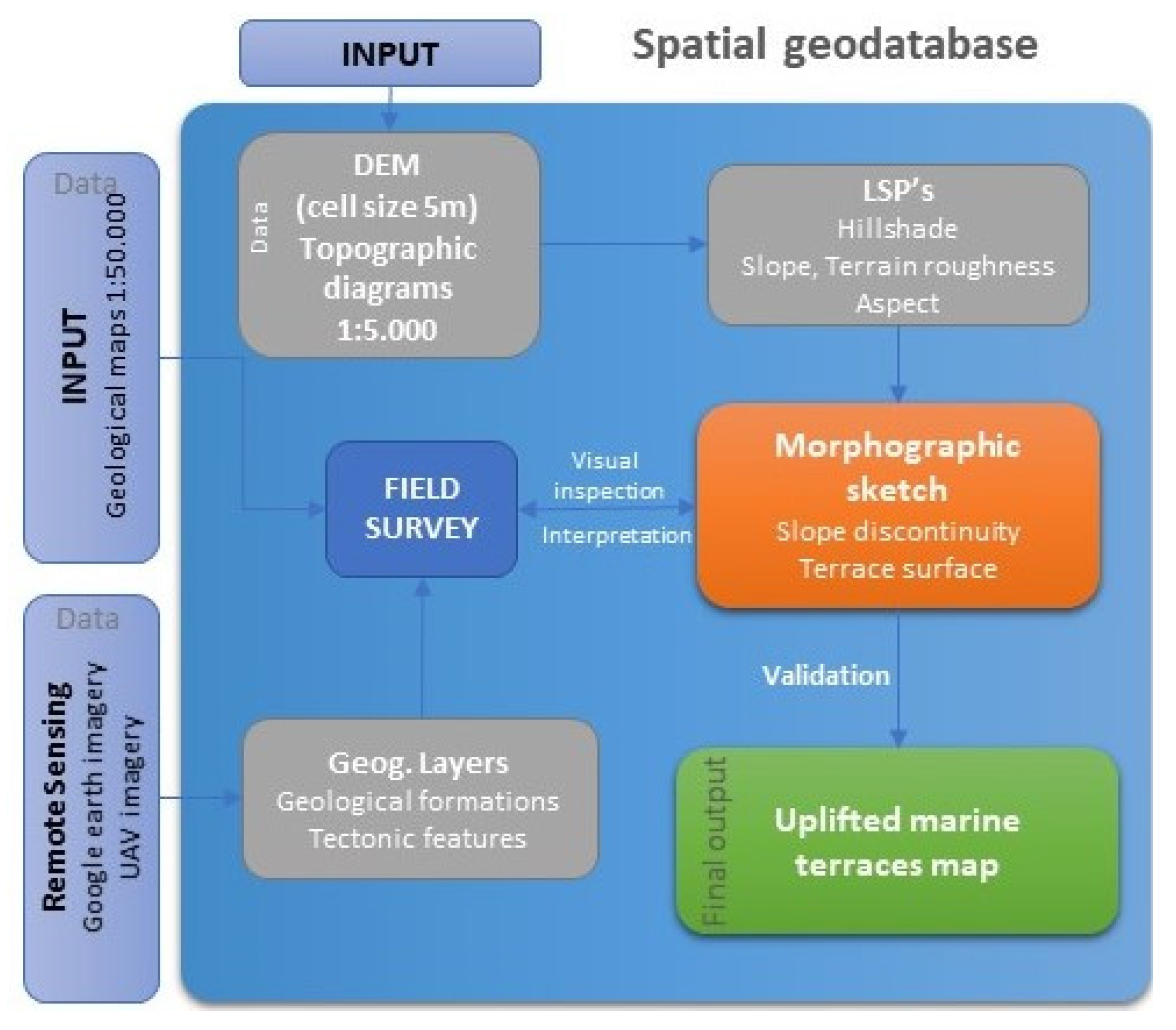
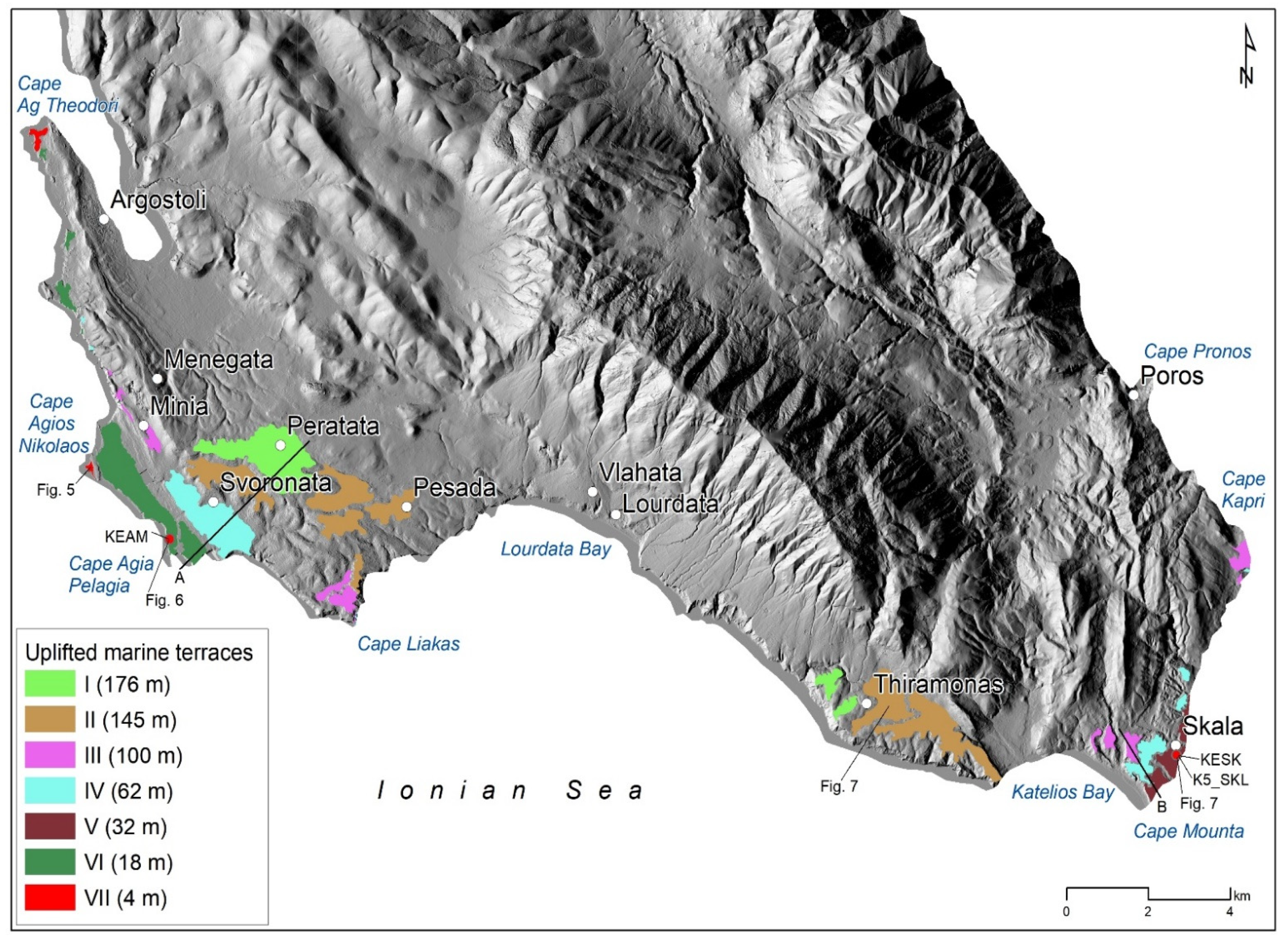


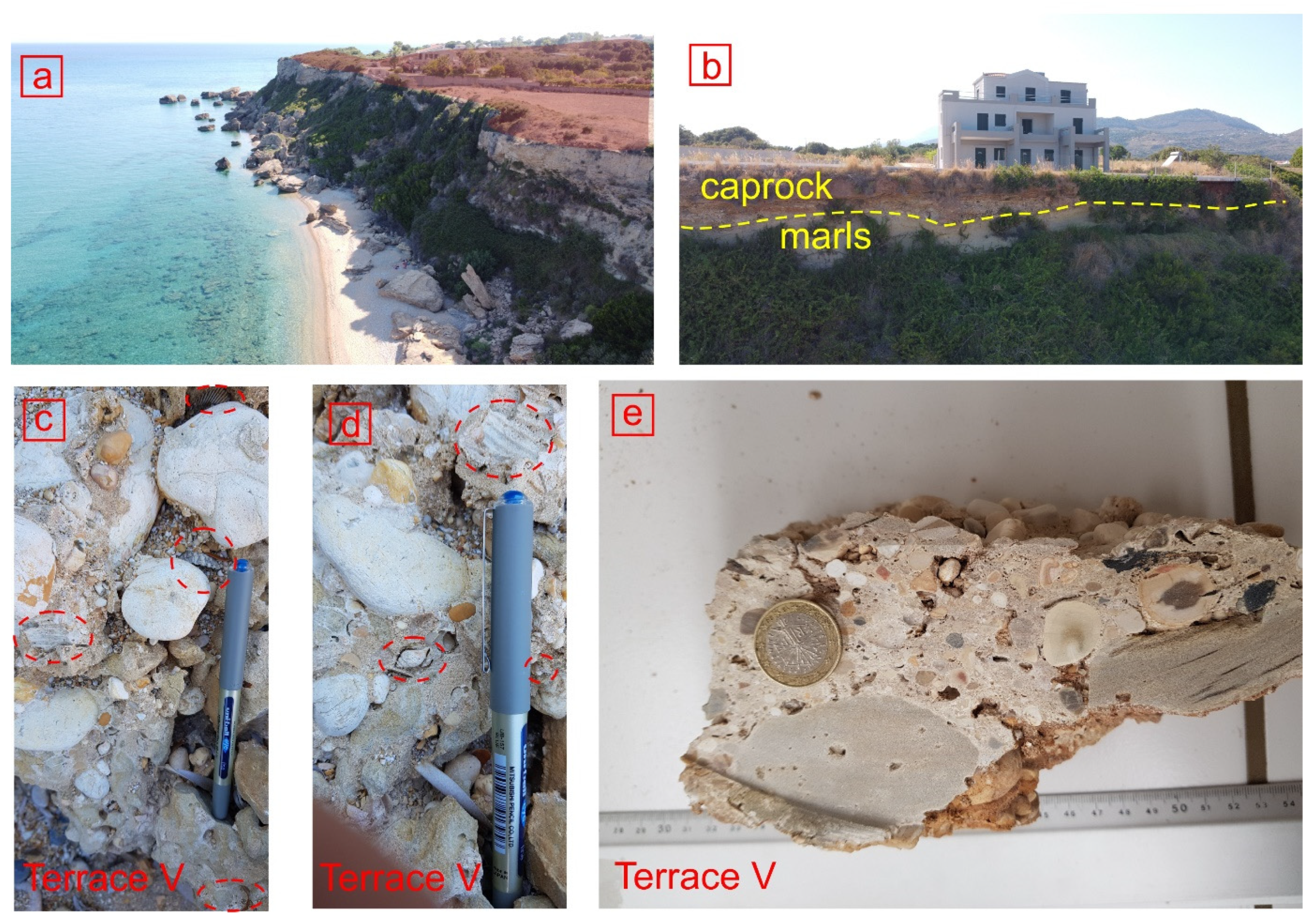
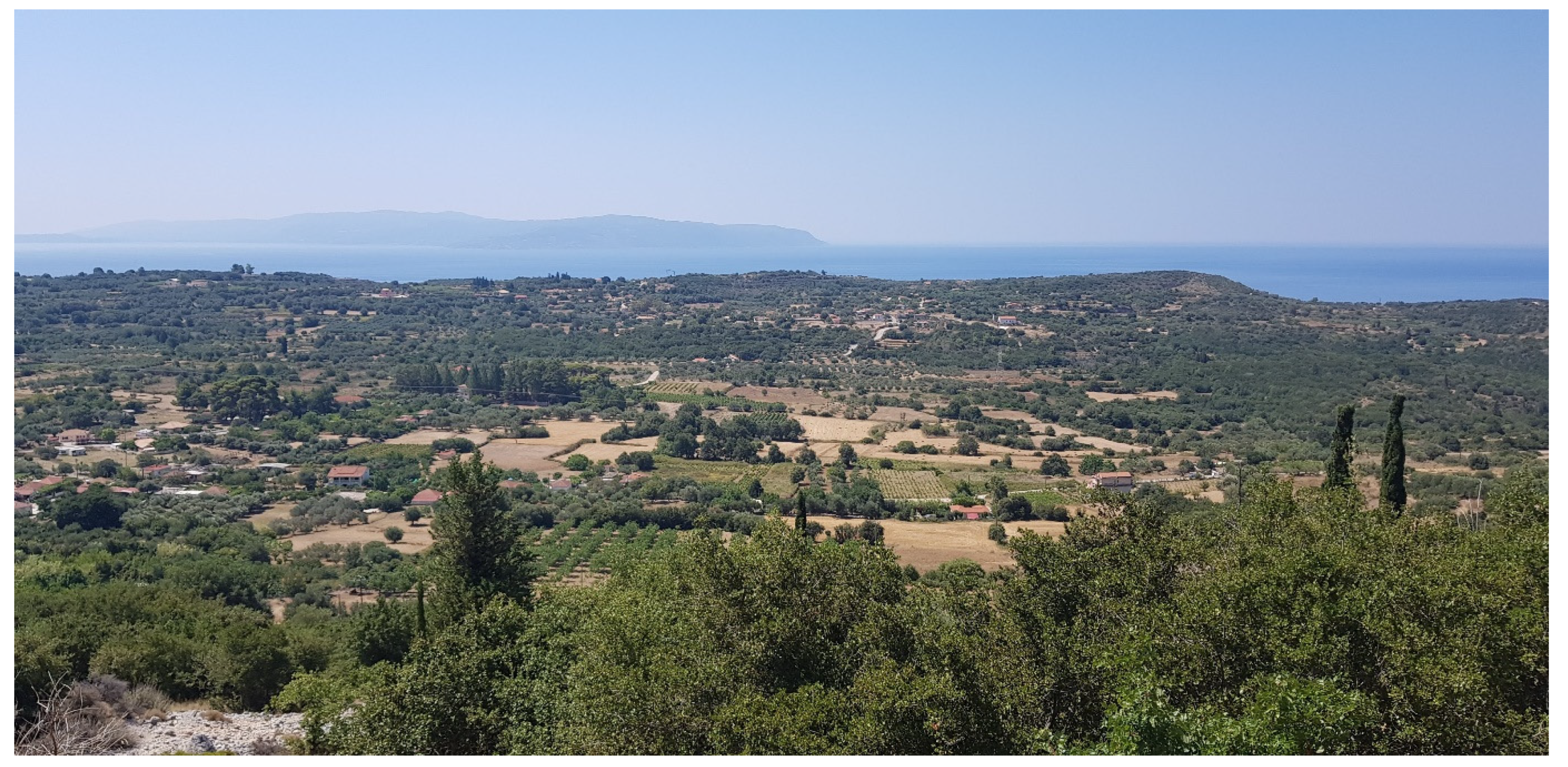
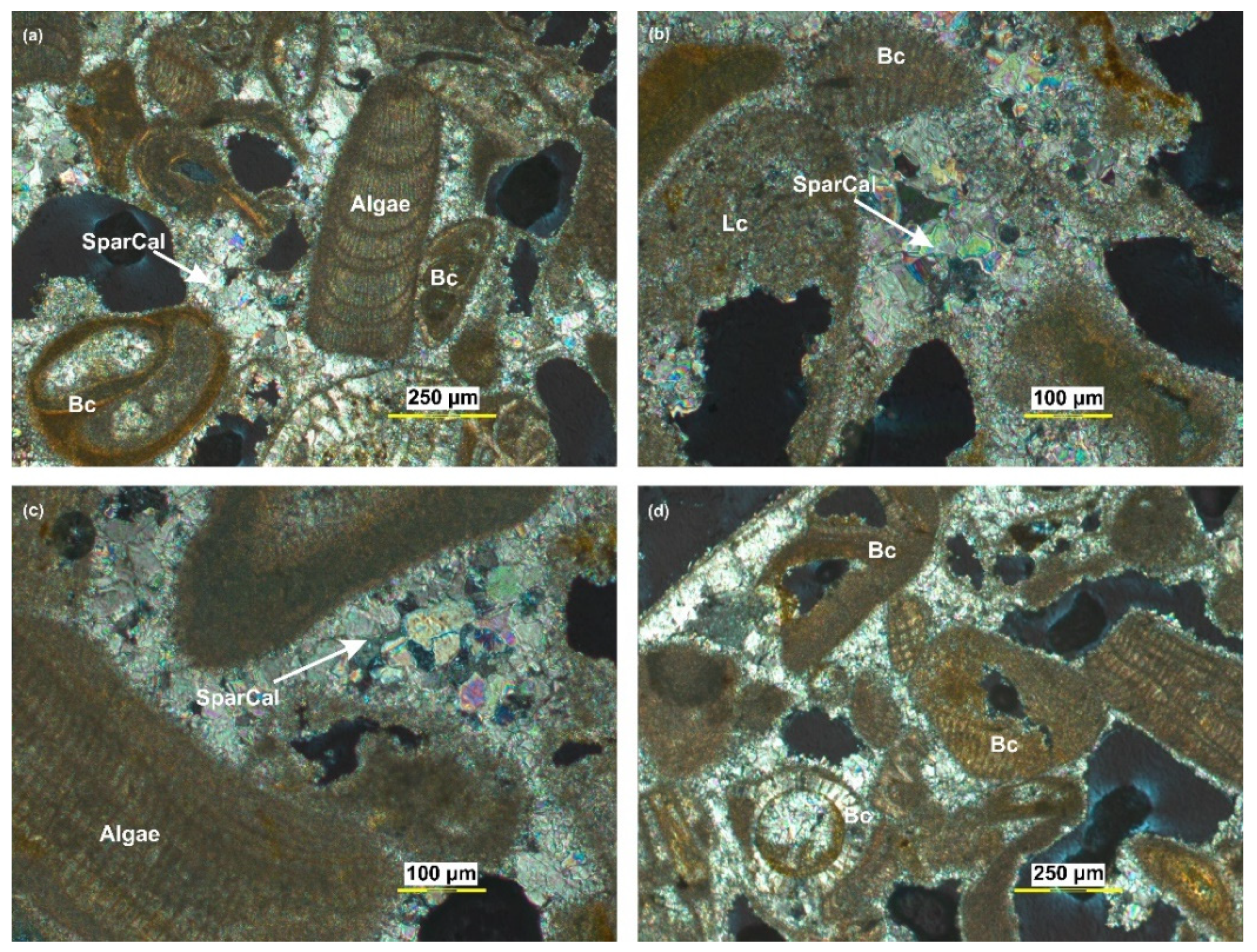
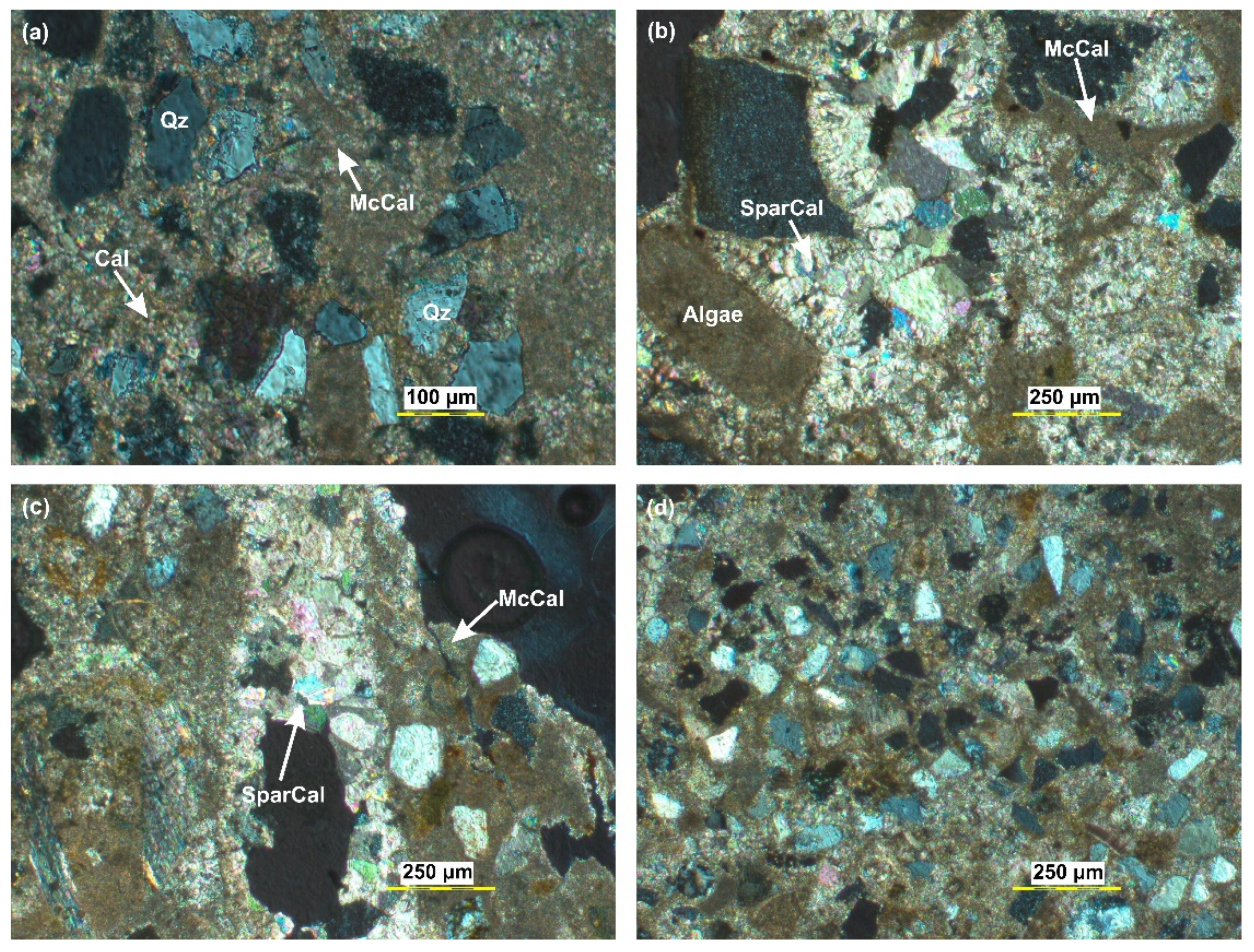
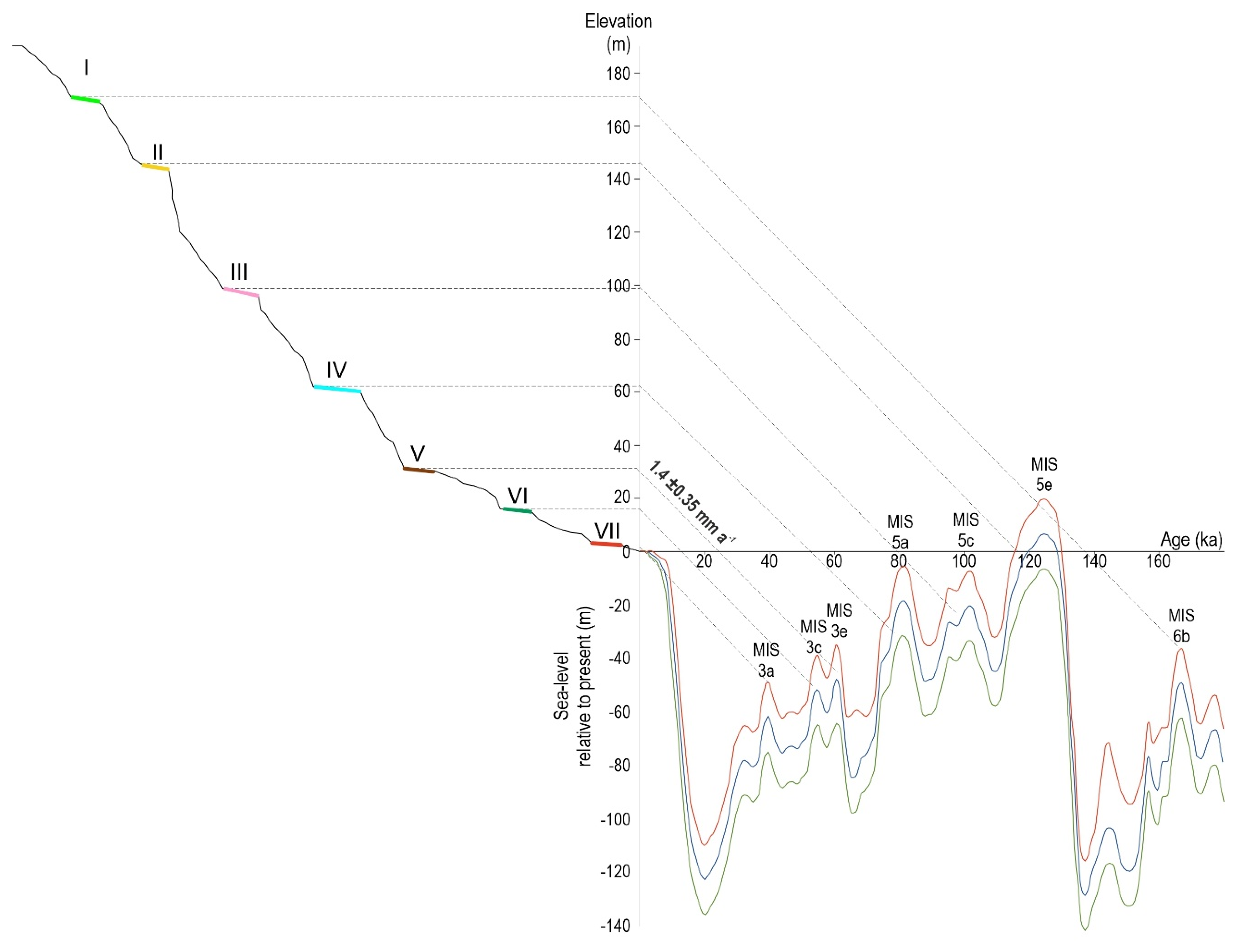

| Sample Sample ID | Lab. Reference | Beta (Gy ka−1) | Gamma (Gy ka−1) | Water Content (wt%) | Total Dose Rate (Gy ka−1) | De | (n) Accepted/Measured | Age (ka) ± 1σ SE |
|---|---|---|---|---|---|---|---|---|
| K5_SKL | GdTL-3859 | 0.299 ±0.19 | 0.245 ±0.11 | 25±5 | 0.492 ± 0.031 | 40.5 ± 1.2 | 23 (24) | 59.1 ±0.3 |
Publisher’s Note: MDPI stays neutral with regard to jurisdictional claims in published maps and institutional affiliations. |
© 2022 by the authors. Licensee MDPI, Basel, Switzerland. This article is an open access article distributed under the terms and conditions of the Creative Commons Attribution (CC BY) license (https://creativecommons.org/licenses/by/4.0/).
Share and Cite
Tsanakas, K.; Saitis, G.; Evelpidou, N.; Karymbalis, E.; Karkani, A. Late Pleistocene Geomorphic Evolution of Cephalonia Island, Western Greece, Inferred from Uplifted Marine Terraces. Quaternary 2022, 5, 35. https://doi.org/10.3390/quat5030035
Tsanakas K, Saitis G, Evelpidou N, Karymbalis E, Karkani A. Late Pleistocene Geomorphic Evolution of Cephalonia Island, Western Greece, Inferred from Uplifted Marine Terraces. Quaternary. 2022; 5(3):35. https://doi.org/10.3390/quat5030035
Chicago/Turabian StyleTsanakas, Konstantinos, Giannis Saitis, Niki Evelpidou, Efthimios Karymbalis, and Anna Karkani. 2022. "Late Pleistocene Geomorphic Evolution of Cephalonia Island, Western Greece, Inferred from Uplifted Marine Terraces" Quaternary 5, no. 3: 35. https://doi.org/10.3390/quat5030035
APA StyleTsanakas, K., Saitis, G., Evelpidou, N., Karymbalis, E., & Karkani, A. (2022). Late Pleistocene Geomorphic Evolution of Cephalonia Island, Western Greece, Inferred from Uplifted Marine Terraces. Quaternary, 5(3), 35. https://doi.org/10.3390/quat5030035










